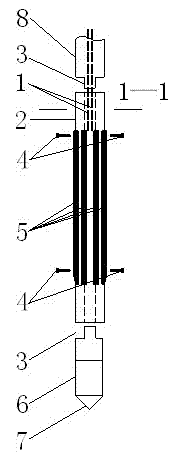In-situ continuous penetrating probe used in non-aqueous phase liquids (NAPLs) polluted sandy soil field investigation
A sandy soil and site technology, applied in the field of surveying penetrating probes, can solve problems such as difficult to effectively detect NAPLs contaminated soil, and achieve the effects of rapid screening, accurate measurement, and improved reliability
- Summary
- Abstract
- Description
- Claims
- Application Information
AI Technical Summary
Problems solved by technology
Method used
Image
Examples
Embodiment Construction
[0020] The present invention will be further described below in conjunction with the accompanying drawings and embodiments.
[0021] like figure 1 , figure 2 As shown, the present invention includes a probe rod 8, and a friction barrel 6 and a conical probe 7 (i.e. a traditional static penetrometer probe) are arranged successively below the probe rod 8; between the probe rod 8 and the friction barrel 6 A time domain reflectometry test probe is installed; the structure of the time domain reflectometry test probe is as follows:
[0022] In the present invention, the upper end of the hollow Derlin rod 2 is connected with the probe rod 8 with a screw thread 3; six stainless steel needles 5 that are symmetrically distributed are embedded on a cylindrical surface in the middle of the Derlin rod 2; the upper and lower ends of the six stainless steel needles 5 are connected to the Derlin rod 2 respectively Fix with 12 screws 4; two coaxial cables 1 pass through the hollow part of t...
PUM
| Property | Measurement | Unit |
|---|---|---|
| Diameter | aaaaa | aaaaa |
| Length | aaaaa | aaaaa |
Abstract
Description
Claims
Application Information
 Login to View More
Login to View More - R&D
- Intellectual Property
- Life Sciences
- Materials
- Tech Scout
- Unparalleled Data Quality
- Higher Quality Content
- 60% Fewer Hallucinations
Browse by: Latest US Patents, China's latest patents, Technical Efficacy Thesaurus, Application Domain, Technology Topic, Popular Technical Reports.
© 2025 PatSnap. All rights reserved.Legal|Privacy policy|Modern Slavery Act Transparency Statement|Sitemap|About US| Contact US: help@patsnap.com



